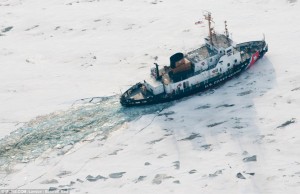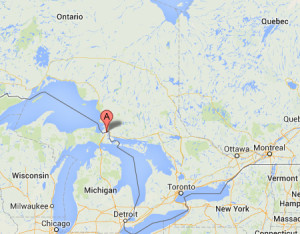Lake Superior may freeze over completely for the first time since 1996
Daily News Article — Posted on February 11, 2014
(from UPI News Agency) MINNEAPOLIS (UPI) — Great Lakes shipping companies are anticipating rough conditions this spring due to extensive icing over this year, a trade group executive said.
“Lake Superior is likely going to ice over completely. In all probability, that means it’s going to be a very tough breakout in March,” said Glen Nekvasil, vice president of the Lake Carriers’ Association.
Lake Superior was estimated to be 93.5 percent ice bound as of Friday. If it freezes over completely, it would be the first time that has happened since 1996, the (Minneapolis) Star-Tribune reported Saturday. [George Leshkevich with the Great Lakes Environmental Research Laboratory said that coverage sways from year to year, but “back in the ’70s and ’80s, there was fairly good ice cover every year.”]
The Great Lakes Environmental Research Laboratory, which monitors lake conditions, said 79.6 percent of the five Great Lakes were iced over. A record 94.7 percent of the lakes were frozen over in 1979.
The Soo Locks at St. Marie, Minn., [Sault Ste. Marie, Michigan*] are scheduled to open March 25, signaling the start of the Great Lakes shipping season. [*UPI News had it wrong and we missed the mistake – thanks to Michigan teacher Elizabeth C. for letting us know:)]
“But right now we’re not getting any relief … it’s a good, old-fashioned winter,” said Mark Barker, president of the Interlake Steamship Co., which ships raw materials such as coal and limestone.

The ice cutters have been making clear paths through St. Mary’s River and the Soo Locks as blocks of ice forms in the Great Lakes. The Bristol Bay (seen here in December) is one being used to try and keep the channels open.
At some point, the Coast Guard will try to plow a path with ice-breakers, but a prolonged deep freeze means that, come spring thaw, the Coast Guard will be challenged to keep up.
“In this case, we have heavy ice over multiple locations. That takes those [Coast Guard] assets and spreads them thin,” Barker said.
Reprinted here for educational purposes only. May not be reproduced on other websites without permission from United Press International. Visit the website at UPI .com.
Background

Soo Locks (A), Sault Ste. Marie, MI
The Soo Locks:
- The Soo Locks (sometimes spelled Sault Locks, but pronounced "soo") are a set of parallel locks which enable ships to travel between Lake Superior and the lower Great Lakes.
- A lock is a device for raising and lowering boats between stretches of water of different levels on river and canal waterways. The distinguishing feature of a lock is a fixed chamber in which the water level can be varied; whereas in a caisson lock, a boat lift, or on a canal inclined plane, it is the chamber itself (usually then called a caisson) that rises and falls.
- Locks are used to make a river more easily navigable, or to allow a canal to take a reasonably direct line across land that is not level.
- The Soo Locks are located on the St. Marys River between Lake Superior and Lake Huron, between the Upper Peninsula of Michigan and the Canadian province of Ontario. They bypass the rapids of the river, where the water falls 21 feet.
- The locks pass an average of 10,000 ships per year, despite being closed during the winter from January through March, when ice shuts down shipping on the Great Lakes.
- The winter closure period is used to inspect and maintain the locks.
- The locks share a name (usually shortened and anglicized as Soo) with the two cities named Sault Ste. Marie,in Ontario and in Michigan, located on either side of the St. Marys River. (from wikipedia)
Shipping on the Great Lakes:
- Typically, 50 million tons to 60 million tons of iron ore gets shipped across the Great Lakes on the average year.
- About 25 million tons to 35 million go to Northwest Indiana ports at steel mills in East Chicago, Gary and Burns Harbor.
- Much of it goes from ports in upper Minnesota across Lake Superior, into the Saint Marys River, through the Soo Locks at Sault Ste. Marie in Northern Michigan, down past the Straits of Mackinac and south to the mills at Lake Michigan's southern shore.
- The voyage usually lasts two and a half days but took nearly twice as long in early January because of the ice. A further delay occurs because the Coast Guard will not break ice at night for safety reasons.
- As much as 20 percent of the ore gets shipped during the icebreaking season, which runs between mid-December and mid-April.
- When the Soo Locks close and the iron ore freighters stop coming, the Port of Indiana-Burns Harbor in Portage will continue to handle barges from the Illinois, Mississippi and Ohio rivers.
- Much of the cargo passes through the inland rivers and the Gulf of Mexico on its way to international markets.
- The port also continues to get a fair amount of lake vessels after the traditional shipping season ends. When needed, icebreakers will help them move their cargo. (from nwitimes.com)
